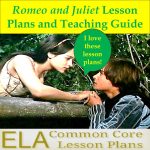Romeo and Juliet Writing Activities: Updating a Scene
Why dost thou read this here teaser fair lad? Now click here and fasten thine eyes on one of my drama lesson plans that involveth rewriting a scene from Romeo and Juliet.
A Job Interview Gone Bad
The interview was going badly. Mr. Dreamcrusher at Nofunded High School refused to laugh, not even when I told him about the time I let students pelt each other with paper clips every time they mispronounced Antigone. I had nothing to lose. I stretched and removed the Romeo and Juliet writing activities, my drama lesson plans, and how to write a scene with updates lesson I had stored in my underwear. I waved them in his face and shouted, “Listen here Mr. Dreamcrusher. I have in my hands the William Shakespeare of Romeo and Juliet writing activities. My favorite includes updating and writing a scene, and I won’t show you this or any other of my drama lesson plans or Romeo and Juliet writing activities unless you hire me!”
Mr. Dreamcrusher has still not seen my drama lesson plans. I will share the one that involves updating a scene in Romeo and Juliet with you.
Writing Assignment

Click the pic and check out the 8-12 week Romeo and Juliet unit plan and teaching guide.
Rewrite a scene from Romeo and Juliet. Update it to modern times. Change the location.
- Prewriting - Look back over the play and select a scene full of action and emotion.
- Prewriting - Think about potential settings for the updated scenes. When brainstorming, write down any possibility, no matter how ridiculous. Some good possibilities are the duel between Mercutio and Tybalt, the meeting of Romeo and Juliet, the balcony scene, the suicide scene.
- Drafting - Change the language. This includes grammar, speech, vocabulary, and even names.
- Drafting - Don’t forget stage directions (it is a play, after all). Adding stage directions allows the writer to more clearly convey the scene.
- Revising - Analyze character motivation. Make sure your characters’ motivations are consistent with their actions. Pay special attention to dialogue.
- Revising - Make sure the language reflects a modern setting.
- Revising - Look at stage directions as a means to dramatize the action.
- Revising - Make sure the characters are still recognizable as Shakespeare intended them.
ELA Common Core Standards Covered
This writing activity satisfies the following Common Core Standards.
W.9-10.3 Write narratives to develop real or imagined experiences or events using effective technique, well-chosen details, and well-structured event sequences.
W.9-10.4 Produce clear and coherent writing in which the development, organization, and style are appropriate to task, purpose, and audience. (Grade-specific expectations for writing types are defined in W.9-10.1-3.)
W.9-10.5 Develop and strengthen writing as needed by planning, revising, editing, rewriting, or trying a new approach, focusing on addressing what is most significant for a specific purpose and audience. (Editing for conventions should demonstrate command of L.9-10.1-3.)
RL.9-10.4 Determine the meaning of words and phrases as they are used in the text, including figurative and connotative meanings; analyze the cumulative impact of specific word choices on meaning and tone (e.g., how the language evokes a sense of time and place; how it sets a formal or informal tone).
L.9-10.1b Use various types of phrases (noun, verb, adjectival, adverbial, participial, prepositional, absolute) and clauses (independent, dependent; noun, relative, adverbial) to convey specific meanings and add variety and interest to writing or presentations.
L.9-10.2 Demonstrate command of the conventions of standard English capitalization, punctuation, and spelling when writing.
L.9-10.2b Use a colon to introduce a list or quotation.
L.9-10.2c Spell correctly. Knowledge of Language
L.9-10.3 Apply knowledge of language to understand how language functions in different contexts, to make effective choices for meaning or style, and to comprehend more fully when reading or listening.
L.9-10.4 Determine or clarify the meaning of unknown and multiple-meaning words and phrases based on grades 9-10 reading and content, choosing flexibly from a range of strategies.
Use context (e.g., the overall meaning of a sentence, paragraph, or text; a word’s position or function in a sentence) as a clue to the meaning of a word or phrase.
L.9-10.4b Identify and correctly use patterns of word changes that indicate different meanings or parts of speech (e.g., analyze, analysis, analytical; advocate, advocacy).
L.9-10.5 Demonstrate understanding of figurative language, word relationships, and nuances in word meanings.
L.9-10.5a Interpret figures of speech (e.g., euphemism, oxymoron) in context and analyze their role in the text.
L.9-10.5b Analyze nuances in the meaning of words with similar denotations.
L.9-10.6 Acquire and use accurately general academic and domain-specific words and phrases, sufficient for reading, writing, speaking, and listening at the college and career readiness level; demonstrate independence in gathering vocabulary knowledge when considering a word or phrase important to comprehension or expression.
Romeo and Juliet Lesson Plans
Students will respond positively to Romeo and Juliet if they are engaged.
- Strategies for Analyzing Shakespeare
- Romeo and Juliet Cause and Effect Lesson Plan
- Teaching Characterization with Romeo and Juliet
- Romeo and Juliet Shields
- Character Interview
- Romeo and Juliet Writing Activity
- Romeo and Juliet Irony Lesson Plan